Anapanasati is the word that the Buddha (Siddhartha Gautama) used to describe his personal meditation technique. This word, in and of itself, tells us everything we need to know in order to practice this technique for ourselves.
Breathing Meditation (Buddha’s Original Recipe)
Anapanasati is the word that the Buddha (Siddhartha Gautama) used to describe his personal meditation technique. This word, in and of itself, tells us everything we need to know in order to practice this technique for ourselves.
In the ancient Indian language of Pali:
“Ana” means “Inhale”
“Pana” means “Exhale”
“Sati” means “Mindfulness” (or “Attention”)
Anapanasati translates as “Inhale / Exhale Mindfulness,” or “Mindfulness of Inhaling and Exhaling.” For simplicity, we call it “Mindfulness of Breathing.”
Any way you slice it, this technique involves choosing the breathing process as the focus of the attention (object of meditation).
Like all meditation techniques, we use the object of meditation as an “attentional anchor” around which we can develop the four faculties of attention, the Attention Control Muscles:
The brain’s ability to:
- consciously notice where its attention is focused at any given moment
- consciously choose an object on which to focus its attention
- hold its attention on one object for an extended period of time
- notice, but not be distracted by, other phenomena while maintaining full attention on one object
The Breath
The breath may seem like the simplest of meditation objects, but in fact it is a many-faceted thing. There are many aspects of the breath into which we can pour our attention. It can be helpful to familiarize yourself with the various aspects of the breath in order to either widen or narrow your range of focus.
As you inhale and exhale, many things happen simultaneously in your body. In fact, so many things happen that I could not possibly list them all in this article. What I will do is pick out some of the more obvious ones and describe them here.
1. The sensation of airflow on your nostrils and the inside surface of your nose, which can even sometimes be traced all the way down the wind-pipe.
2. The inflation and deflation of your abdomen.
3. The subtle differences in your consciousness between the states of “fullness” and “emptiness” of breath.
4. The quality of the breath; its length (how long it takes to inhale and exhale), and its coarseness (or softness).
5. The ways that the length / coarseness of your breath affect your consciousness.
Some people choose to focus on the sensations in the airway. Some people choose to focus on the inflation/deflation of the abdomen. Some people choose to focus on the length and/or coarseness of the breath.
What I would recommend, for a beginning meditator, is to start with one aspect, and focus as hard as you can on that one aspect, for the duration of your meditation session. Don’t jump between them; that’s not helping. The point of this exercise is for you to willfully hold your attention on one thing. If you’re jumping between multiple objects, you’re just defeating the purpose and your Attention Control Muscles will remain weak and atrophied.
What you choose is really not important; the important thing is that you stick to it.
From the writings of the Buddha in the Pali Canon, it seems that he focused on #4 (and maybe #5 as well). He was focused on how long each breath took to come in and out, and how each type of breathing “conditioned” (affected) his body and mind.
So, if you want to try out the Buddha’s Original Recipe, you may be best off choosing to focus on #4 + #5 as well.
Also, remember not to force your breath. That means, don’t try to control it. Don’t try to make it faster, slower, deeper, shallower, etc. You can experiment with these different breathing types, but when you meditate, you are watching your breath as it naturally flows. You are like an observer, watching yourself breathing as you would watch an animal in a zoo. You watch with curiosity and interest; you don’t try to control anything… you’d rather be able to see how the animal is in its natural environment. You are developing awareness of yourself.
The practice of meditation that we have today is based on the Buddha’s words in the Anapanasati Sutta. Here is an excerpt that may help clarify things for you:
Breathing in long, he [the meditator] apprehends, ‘I am breathing in long’
Breathing out long, he apprehends, ‘I am breathing out long.’
Breathing in short, he apprehends, ‘I am breathing in short’
Breathing out short, he apprehends, ‘I am breathing out short.’
He trains himself, ‘I will breathe in sensitive to the entire body.’
He trains himself, ‘I will breathe out sensitive to the entire body.’
The Buddha goes on to contemplate concepts and cultivate insight through this practice.
However, I have decided not to get into those concepts and insights in this article. There is a very good reason for this. I want you to develop these insights naturally, and not have them forced into your mind by an external source.
In my experience, if you are focusing correctly, you will experience all of the Buddha’s insights on a very deep level. They arise from within, not in the form of words, thoughts, or concepts, but as deep understandings which stem from seeing something with your very own eyes. It’s the difference between someone telling you that the sky is blue, versus actually seeing the sky for yourself. You don’t need to verbalize the blueness of the sky; it is plain to see. It is the same with these insights; when your mind is completely still and free of all pre-fabricated belief, you are able to see everything clearly for the first time.
This “clear seeing” is what’s known as “vipassana.” Vipassana is often referred to as “Insight Meditation.” In fact, Vipassana comes from the Pali root “pas,” meaning “sight,” with the prefix “vi,” meaning “clear.” Literally, “Vipassana” translates into English as “clear sight,” or “clear seeing.”
How to Focus
Now that we’ve chosen an object of meditation, we simply allow the attention to rest upon the breath.
If it were that simple, however, we wouldn’t need to meditate. There are many challenges that arise that make meditation much more difficult.
The challenges that arise tend to come in the form of “sensory stimuli.”
In the Western way of looking at things, we have five senses: sight (eyes), sound (ears), taste (tongue), smell (nose), touch (body). In the Eastern paradigm, thought (brain) is considered a sixth sense. Just as the sound of a bird strikes the eardrum, so does the energy of a thought strike the brain.
Either way you look at it, the challenges to meditation all come from those six sources; the eyes, the ears, the tongue, the nose, the feeling body, and the thinking mind.
When a thought pops into your head, when the sound of a car horn hits your eardrum, when the feeling of an itch arises on the top of your head… don’t react to it. Don’t get involved with the thought, don’t get annoyed at the car horn, don’t move to scratch the itch. Keep your body perfectly still, and keep your mind perfectly still (resting on the breathing). Just keep your attention on your breath. Allow yourself to notice that the sensory stimulus is present (without analyzing or understanding it)… but keep your attention on your breath. Notice the stimulus as it arises, notice how it changes as it continues to exist over time, and notice how it passes away, dissolving back into the fabric of reality. But remember to keep your attention on your breath, all the while.
If you are successful in doing this, you will develop all of the insights that mystics have been speaking about (but sadly never able to communicate to the general population) for generations upon generations. You will become a part of a long line of people to experience this realization; a line which extends way back, beyond Jesus and Abraham, for thousands of years before we humans began recording our history.
Keep the attention on the breath at all times. IF you find that your attention has wandered into something else, and you have lost the breath, simply bring the attention back to the breath, gently, and happily. Notice this “wandering of attention” just as you noticed all of the other phenomena… but bring your attention back to your breath and do not dwell on it “the wandering” more.
How Long To Meditate
You can practice meditation for as short or long a time as you feel comfortable with. There are people who have a fulfilling practice, meditating only five minutes per day, and there are people who have been meditating non-stop for months, and even years in some extreme cases.
In my experience, it is useful to choose your time-frame before you sit down to start meditating.
Setting an alarm can also be a useful trick. When it rings, it brings you into the present moment and forces you to notice where your attention is at the moment of ringing.
If the alarm startles you, it means that your attention has been lost in thoughts. Being “startled” is the jolt you feel when you are pulled suddenly from the thought-world to the real-world. If you have been keeping your attention on the breath (part of the real-world), you will not feel startled by the alarm. In fact, you will notice the sound (and/or vibration) precisely as it arises, just as you would notice any other sensory stimulus that enters your perceptual field. If your mind has been wandering, the alarm enters harshly; if your mind is concentrated in the present moment, the alarm enters peacefully.
For a beginner, I would actually recommend starting with short, five-minute meditation intervals.
What I do, when I’m not in a particularly “meditative” mood, is set my iPhone alarm for five minutes. Then I sit up straight and begin watching my breath.
When the alarm goes off, I notice whether the sound arises smoothly or harshly, peacefully or startlingly. This is like a quick litmus test that helps with my mindfulness; it forces me to realize, after only a few minutes, whether my mind is wandering or not. This gives me the opportunity to adjust my level of effort, based on my brain’s natural level of concentration at the moment.
If I find that my mind has been wandering, I go into my next meditation segment with a bit more effort, willpower, and determination. If I find that my attention has been resting steadily on the breath, I go into my next meditation segment smoothly, restfully, without changing my level of effort.
The more concentrated your mind is, the easier it is to maintain attention. The hardest part of developing your attention control muscles is getting through the first stage… the “restless, chattering, wandering mind” phase. During this phase, it is important to maintain some level of effort in keeping the attention on the breath. Once your mind has become concentrated and quiet, and the attention rests easily on the breath, it can be better to let go of the effort, and just allow yourself to relax into your breath. Through this relaxed, easy focus, you can become more and more absorbed into the breath, and the mind can become more and more concentrated, since it no longer has to concern itself with effort, or “trying to do something.”
If the alarm startles me, I know that I’m still in the “wandering mind” phase, so I increase my effort level by focusing hard on my breathing. If the alarm arises as part of the meditation, I maintain my mindfulness, and allow myself to relax into an even deeper absorption in the breath.
Either way, I mindfully press the “start” button on my iPhone timer, which restarts the alarm. This gives me another five-minute segment. When the alarm rings at the end of this segment, it gives me another chance to see my level of mindfulness, in the same way. I then press the “start” button again.
My current morning routine is to meditate for 15 minutes in this way. You can do as many segments as you feel like doing, but make sure you don’t stop in the middle of a segment. Consider each five-minute segment as a commitment; this will help you resist the urge to cave in to your brain’s constant demand for stimulation.
It’s also useful to try out different segment-lengths. One day, when you have a bit more free time, you can try out ten-minute segments instead of five-minute segments to see how it goes. It’s also important for you to experience what you might call a “full-length” meditation every so often (half an hour or more, uninterrupted), when you get a chance.
Posture
One thing that I never understood about sitting meditation is why we have to sit in such uncomfortable postures. What’s the point?
The skeptical, modernistic part of me decided that the “lotus” posture was simply the best they could do in the time of the Buddha. They didn’t have chairs, so they had to sit on the ground in a position that they could maintain for a long time. In our age of plush sofas and cozy reclining chairs, the lotus posture is obsolete.
However, over several years and much experimentation, I have found the lotus posture to be most conducive to developing the meditative states of deep concentration.
When I meditate in a lying-down position (on a bed or a sofa, or even on the floor), I fall asleep. Relaxation so deep naturally leads down that path. When I meditate in a very comfortable reclining position, my mind tends to wander, and I end up falling asleep as well. I have found that the slightly uncomfortable cross-legged lotus-style positions are the best postures for developing a state of relaxed, yet completely alert consciousness.
Here are the three postures that I have found to the most useful. Depending on your body, you may find some of them more challenging than others. I would recommend starting out with a position that’s relatively easy for you.
The Burmese Position should be relatively easy for anybody to get into. The Lotus positions require a bit more flexibility. The trick is to open the hips, instead of trying to bend your knees in weird directions.
Here’s a step-by-step on how to get into the Lotus positions:
- Sit on the ground with your legs straight out in front of you (toes pointing toward the ceiling).
- Rotate your right hip outward (your toes should drop toward the floor on your right). Your entire leg should rotate outward.
- While keeping the outside of your right foot on the floor, bring it toward you (your knee will move outward, toward the right).
- Pick up your right foot with your hands, and bring it gently toward your body. Try to touch it to your nose.
- Gently lay your right foot down on your left thigh, as close to your left hip as possible.
- Now rotate your left hip outward (your toes should drop toward the floor on your left). Your entire leg should rotate outward.
- While keeping the outside of your left foot on the floor, bring it toward you (your knee will move outward, to the left).
- Go into either Half Lotus or Full Lotus.
- To go into Half Lotus, slowly sweep your left foot underneath your right thigh.
- To go into Full Lotus, slowly raise your left foot with your hands, bring it toward your body, and lay it gently on your right thigh, as close to your right hip as possible.
- Straighten up! Sit so that your spine is straight, and the top of your head is as high as you can get it.
- Rest your hands in a comfortable position (covering your knees is fine, or resting in your lap).
- Relax your muscles, breathe deeply, and feel your entire body. Keep your eyes gently closed, or gently looking at the ground in front of you. You are now ready to begin focusing on the breath.
If you can get into one of the Lotus positions, great! They are arguably the best positions for powerful meditation. Be sure to switch legs every time you meditate, in order to stretch both hips equally. These positions are great for stretching the muscles in the hips and thighs; try to feel the stretch every time, and be mindful of the sensations.
Go slowly, don’t push yourself too hard. Some people take years to develop the flexibility needed to get into Full Lotus. Also, remember that once you get into the position, you’ll have to get out; and that’s not as easy as it sounds. Remember this trick in case you “get stuck” in Full Lotus: put both hands on the floor and push your butt off the ground. Leaning on your hands in this way can take some of the pressure off of your legs and make it easier to get out of the Full Lotus position.
In all of these postures, you will develop pain. Everyone does; it’s not just you. You may have pain in your back, in your neck, or your legs. Over time, your legs will fall asleep. Don’t worry; this pain is only temporary. You may be worried that allowing your legs to fall asleep will cause permanent damage to them. This is not the case. You are not actually cutting off the blood flow, you are only pressing on the nerve. Watching the legs fall asleep can actually give you some fascinating insights into your instinctual reactions to painful sensations.
You must greet these sensations and phenomena with equanimity; don’t try to resist them, just see the sensations as clearly as you can. While your attention remains centered on your breath, you may have enough peripheral attention to notice the feelings in your legs as the first tingling sensations arise, as they spread through the legs, and how they pass away when the legs are asleep. You may notice the numbness as it abides, and you may notice the sensations that sweep through your legs when they “wake up” again.
Here’s another tip, in case you want to stop your legs from falling asleep. Moving your legs doesn’t help very much. The nerve you’re compressing is most likely in your thigh or buttocks. The best way to uncompress the nerve is to place your hands on the floor, prop yourself up, and lift your buttocks off the ground for a few seconds. You may even want to swing your hips back and forth a little bit, while leaving your legs in the same position. You should start to feel the rush of sensations within a few seconds. Then you can sit back down and continue your meditation.
Through all of this positioning and re-positioning, try to keep as much of your attention on the breath as you possibly can!
In general, I would recommend that you try to sit perfectly still and watch your legs fall asleep, watch the painful sensations move through your body without resisting them. This develops deep equanimity. If the pain becomes so distracting that you can’t keep your focus on your breath, then shift MINDFULLY, while keeping the attention on the breath.
Remember, don’t try to force anything; if you have pain in your knee, stop. The last thing you need is an injured knee or ankle. If you’re having trouble, check out these videos.
Learn How To Do Yoga Half Lotus Pose Here
Learn How To Do Yoga Full Lotus Pose Here
As You Get Deeper And Deeper…
At the beginning, when you just begin to meditate, you will have a very hard time. Thoughts will be bouncing around all over the place, and you’re going to get easily drawn into them. You will be distracted by everything; thoughts, sights, sounds, pain, pleasure… you’ll barely be able to keep your attention on your breath for more than a few seconds. Your mind goes wandering around, following endless streams of thought for long spans of time… even minutes or hours on end… before you even notice that you are no longer paying attention to your breathing.
Every so often, you’ll notice that you have actually watched the entirety of an inhale, an exhale, or maybe even a cycle of in-and-out breaths. You’ve seen the inhale from the beginning, you’ve seen it slow down, and reverse directions into an exhale, slow down, and reverse directions again as the air pulls back in through your nostrils. This is progress. Your Attention Control Muscles are getting stronger.
Over time, maybe a few minutes, days, a few weeks, months, years… the gaps of time between thoughts get wider and wider. Your attention rests more easily on the breath, and you can see inhale, exhale, inhale, exhale, very clearly. You see the transition points where the inhale ends and the exhale begins, and vise versa. You become extremely relaxed as everything just kinda fades away. You’re still aware of everything; it’s just quieter, less important in some way.
You may be surprised when your eyes drift open at this point, and everything around you is much brighter and more colorful than you remember it. As you keep your attention on your breath, profound feelings of joy & contentment (in Pali: piti & sukkha) overwhelm you.
Life become profoundly beautiful at this moment. This is the moment when people really “get it.” Meditation becomes a joy instead of a chore. This is the point where people become addicted to meditation. In the Buddhist tradition, this moment is called “Satori;” a glimpse of Nirvana. It is the greatest feeling in the world, better than any drug (that I’ve ever tried) or experience (though there are some that come close). Your entire life changes in an instant, and you will never be the same. You have seen heaven on Earth, and you now know that it is always within your reach. Anger, Hatred, Stress, Anxiety will never be able to affect you in the same way again, for the rest of your life. In this instant, you have understood the meaning of life, and all the other great truths of reality.
But, you will lose it. Just as quickly as it came, it will fade away. Your first Satori experience can be extremely powerful, and it gives you the motivation to do it again and again and again. But unfortunately, it only lasts for a few minutes, a few hours, a few days if you’re lucky… and fades away.
As you continue your practice, over the coming months and years, you begin to notice that the joy and contentment of Satori only fade away because you keep trying to hold onto them. You seek the feeling, and avoid its fading away. You desire the feeling, and you fear its fading away. This desiring, this fear… that’s what kills it in the first place.
Once you realize this, you stop clinging to these wonderful feelings. You realize that they are only temporary, and that it’s not worth the stress and anxiety you put yourself through in trying to chase them down and hold onto them. Through the deep changes your meditation practice has been making in your brain structure, you have become “happy” and content with life in general. Those feelings of piti & sukkha are just icing on the cake. You are happy with the nice, stable peace of mind that keeps you loving life all day, every day.
The road doesn’t end here, but this article does. Through the practice of Anapanasati, the wisdom of Enlightenment unfolds naturally, with or without outside input. Reading my words on the later stages of the Anapanasati path will not help you; in fact, it may even be counterproductive. If you know what you’re in for, you may conceptualize it, and over-analyze it when it comes.
Forget words, concepts, and understanding; just sit down and watch your breath.
Now You’re Ready To Get Started
Now that you’ve read through the detailed tutorial on how to use the Anapanasati technique, you’re ready to get started. Here’s a quick step-by-step that you can try right now.
Remember to this every day. It’s better to meditate for five minutes a day, at the same time every day (thus forming a long-lasting habit), than it is for you to prove how awesome you are by starting out with a three-hour meditation.
- Go get your iPhone / Blackberry / Alarm Clock. Put it next to you on the floor, and set it for five minutes. Hit “start.” Let go of past and future; all of your attention is now in the present moment.
- Mindfully, get into position (either Burmese, Half-Lotus, or Full-Lotus). Make sure your back is straight, head high, shoulders down, and try to get your knees to touch the floor.
- Now, start to notice your breathing process. Notice if it’s fast or slow, coarse or soft.
- Keep watching the inhales and exhales as you close your eyes and relax into full concentration.
- Just keep your attention on your breathing, noticing the thoughts, sights, sounds, smells, tastes, and sensations as they arise and disappear, seeing them as they truly are. Always stay centered on the breathing.
Good luck, and may wonder be with you.



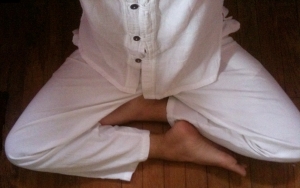
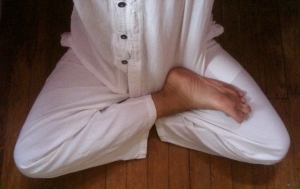
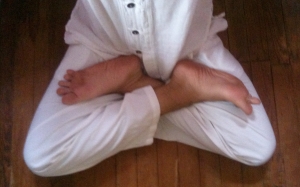

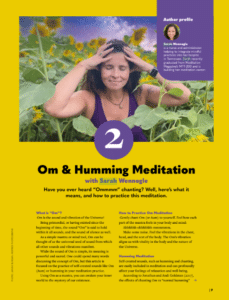



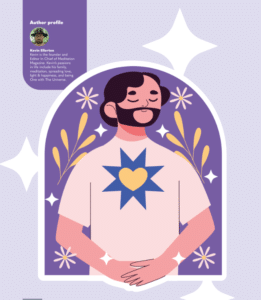

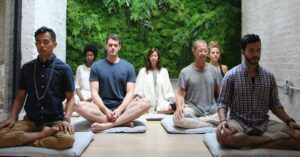
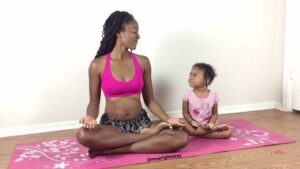



… [Trackback]
[…] There you will find 42256 more Infos: meditationmag.com/blog/breathing-meditation-buddhas-original-recipe/ […]
… [Trackback]
[…] Find More Information here to that Topic: meditationmag.com/blog/breathing-meditation-buddhas-original-recipe/ […]
… [Trackback]
[…] Read More on on that Topic: meditationmag.com/blog/breathing-meditation-buddhas-original-recipe/ […]
… [Trackback]
[…] Find More Info here on that Topic: meditationmag.com/blog/breathing-meditation-buddhas-original-recipe/ […]
… [Trackback]
[…] Here you can find 78115 additional Info to that Topic: meditationmag.com/blog/breathing-meditation-buddhas-original-recipe/ […]
… [Trackback]
[…] Here you can find 60054 additional Info to that Topic: meditationmag.com/blog/breathing-meditation-buddhas-original-recipe/ […]
… [Trackback]
[…] Find More to that Topic: meditationmag.com/blog/breathing-meditation-buddhas-original-recipe/ […]
… [Trackback]
[…] Information on that Topic: meditationmag.com/blog/breathing-meditation-buddhas-original-recipe/ […]
… [Trackback]
[…] Info to that Topic: meditationmag.com/blog/breathing-meditation-buddhas-original-recipe/ […]
… [Trackback]
[…] Find More to that Topic: meditationmag.com/blog/breathing-meditation-buddhas-original-recipe/ […]
… [Trackback]
[…] Here you will find 79658 additional Information to that Topic: meditationmag.com/blog/breathing-meditation-buddhas-original-recipe/ […]
… [Trackback]
[…] Read More here on that Topic: meditationmag.com/blog/breathing-meditation-buddhas-original-recipe/ […]
… [Trackback]
[…] Read More Information here to that Topic: meditationmag.com/blog/breathing-meditation-buddhas-original-recipe/ […]
… [Trackback]
[…] Read More on that Topic: meditationmag.com/blog/breathing-meditation-buddhas-original-recipe/ […]
… [Trackback]
[…] Read More to that Topic: meditationmag.com/blog/breathing-meditation-buddhas-original-recipe/ […]
… [Trackback]
[…] Find More to that Topic: meditationmag.com/blog/breathing-meditation-buddhas-original-recipe/ […]
… [Trackback]
[…] Read More on to that Topic: meditationmag.com/blog/breathing-meditation-buddhas-original-recipe/ […]
… [Trackback]
[…] Read More to that Topic: meditationmag.com/blog/breathing-meditation-buddhas-original-recipe/ […]
… [Trackback]
[…] Read More on that Topic: meditationmag.com/blog/breathing-meditation-buddhas-original-recipe/ […]
… [Trackback]
[…] Read More Information here to that Topic: meditationmag.com/blog/breathing-meditation-buddhas-original-recipe/ […]
… [Trackback]
[…] Find More on to that Topic: meditationmag.com/blog/breathing-meditation-buddhas-original-recipe/ […]
… [Trackback]
[…] Read More here to that Topic: meditationmag.com/blog/breathing-meditation-buddhas-original-recipe/ […]
… [Trackback]
[…] Read More Information here on that Topic: meditationmag.com/blog/breathing-meditation-buddhas-original-recipe/ […]
buy sildenafil over the counter
Breathing Meditation (Buddha's Original Recipe) – Meditation Magazine
where to buy sildenafil without prescription
Breathing Meditation (Buddha's Original Recipe) – Meditation Magazine
soma online us pharmacy
Breathing Meditation (Buddha's Original Recipe) – Meditation Magazine
viagra 30 pills
Breathing Meditation (Buddha's Original Recipe) – Meditation Magazine
what is cialis
Breathing Meditation (Buddha's Original Recipe) – Meditation Magazine
free samples of cialis
Breathing Meditation (Buddha's Original Recipe) – Meditation Magazine
tadalafil 20mg reviews
Breathing Meditation (Buddha's Original Recipe) – Meditation Magazine
tadalafil compounding pharmacy
Breathing Meditation (Buddha's Original Recipe) – Meditation Magazine
sildenafil citrate online pharmacy
Breathing Meditation (Buddha's Original Recipe) – Meditation Magazine
… [Trackback]
[…] Find More here to that Topic: meditationmag.com/blog/breathing-meditation-buddhas-original-recipe/ […]
… [Trackback]
[…] There you will find 96007 more Information to that Topic: meditationmag.com/blog/breathing-meditation-buddhas-original-recipe/ […]
… [Trackback]
[…] Information to that Topic: meditationmag.com/blog/breathing-meditation-buddhas-original-recipe/ […]
generic viagra 2018
Breathing Meditation (Buddha's Original Recipe) – Meditation Magazine
… [Trackback]
[…] Find More to that Topic: meditationmag.com/blog/breathing-meditation-buddhas-original-recipe/ […]
help writing a argumentative essay
Breathing Meditation (Buddha's Original Recipe) – Meditation Magazine
the help essays
Breathing Meditation (Buddha's Original Recipe) – Meditation Magazine
help with writing an essay
Breathing Meditation (Buddha's Original Recipe) – Meditation Magazine
essay writing service cheap
Breathing Meditation (Buddha's Original Recipe) – Meditation Magazine
what is the best online essay writing service
Breathing Meditation (Buddha's Original Recipe) – Meditation Magazine
custom essay writing toronto
Breathing Meditation (Buddha's Original Recipe) – Meditation Magazine
help with writing a essay
Breathing Meditation (Buddha's Original Recipe) – Meditation Magazine
application essay writing service
Breathing Meditation (Buddha's Original Recipe) – Meditation Magazine
top 10 essay writing services
Breathing Meditation (Buddha's Original Recipe) – Meditation Magazine
cheap custom essay writing service
Breathing Meditation (Buddha's Original Recipe) – Meditation Magazine
civil service essay
Breathing Meditation (Buddha's Original Recipe) – Meditation Magazine
buy an essay cheap
Breathing Meditation (Buddha's Original Recipe) – Meditation Magazine
english literature essay help
Breathing Meditation (Buddha's Original Recipe) – Meditation Magazine